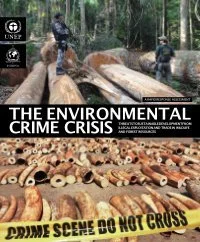The Environmental Crime Crisis – Threats to Sustainable Development from Illegal Exploitation and Trade in Wildlife and Forest Resources. A UNEP Rapid Response Assessment
By Nellemann, C., Henriksen, R., Raxter, P., Ash, N., Mrema, E. (Eds)
Given the alarming pace, level of sophistication, and globalized nature that illegal trade in wildlife has now notoriously achieved, UNEP initiated a Rapid Response Assessment to provide some of the latest data, analysis, and broadest insights into the phenomenon. Tackling illegal wildlife trade demands this examination of the relationship between the environmental resources at stake, their legal and illegal exploitation, the loopholes that exacerbate the situation, the scale and types of crimes committed, and the dynamics of the demand driving the trade. In the international community, there is now growing recognition that the issue of the illegal wildlife trade has reached significant global proportions. Illegal wildlife trade and environmental crime involve a wide range of flora and fauna across all continents, estimated to be worth USD 70–213 billion annually. This compares to a global official development assistance envelope of about 135 billion USD per annum. The illegal trade in natural resources is depriving developing economies of billions of dollars in lost revenues and lost development opportunities, while benefiting a relatively small criminal fraternity. This report focuses on the far-reaching consequences of the environmental crime phenomenon we face today. The situation has worsened to the extent that illegal trade in wildlife’s impacts are now acknowledged to go well beyond strictly environmental impacts – by seriously undermining economies and livelihoods, good governance, and the rule of law. Even the security and safety of countries and communities is affected: the report highlights how wildlife and forest crime, including charcoal, provides potentially significant threat finance to militias and terrorist groups. Already recognized as a grave issue in DRC and Somalia by the UN Security Council, the assessment reveals that the scale and role of wildlife and forest crime in threat finance calls for much wider policy attention, well beyond those regions. The consequences are increasingly evident: illegal wildlife trafficking constitutes a barrier to the achievement of both sustainable development and environmental sustainability. As reflected in a range of decisions of the Convention on International Trade in Endangered Species of Wild Fauna and Flora, the UN Office for Drugs and Crime, the UN Commission on Crime Prevention and Criminal Justice, INTERPOL, the UN Security Council, and others, the illegal trade in wildlife and environmental crime are now widely recognized as significant threats on a global scale, to be tackled with urgency. However the responses to date, in terms of impact on the ground, have been too modest, and inadequate to the scale and growth of the threat to wildlife and the environment.
Nairobi: United Nations Environment Programme; Arendal, Norway: GRID-Arendal. 2014. 108p.


